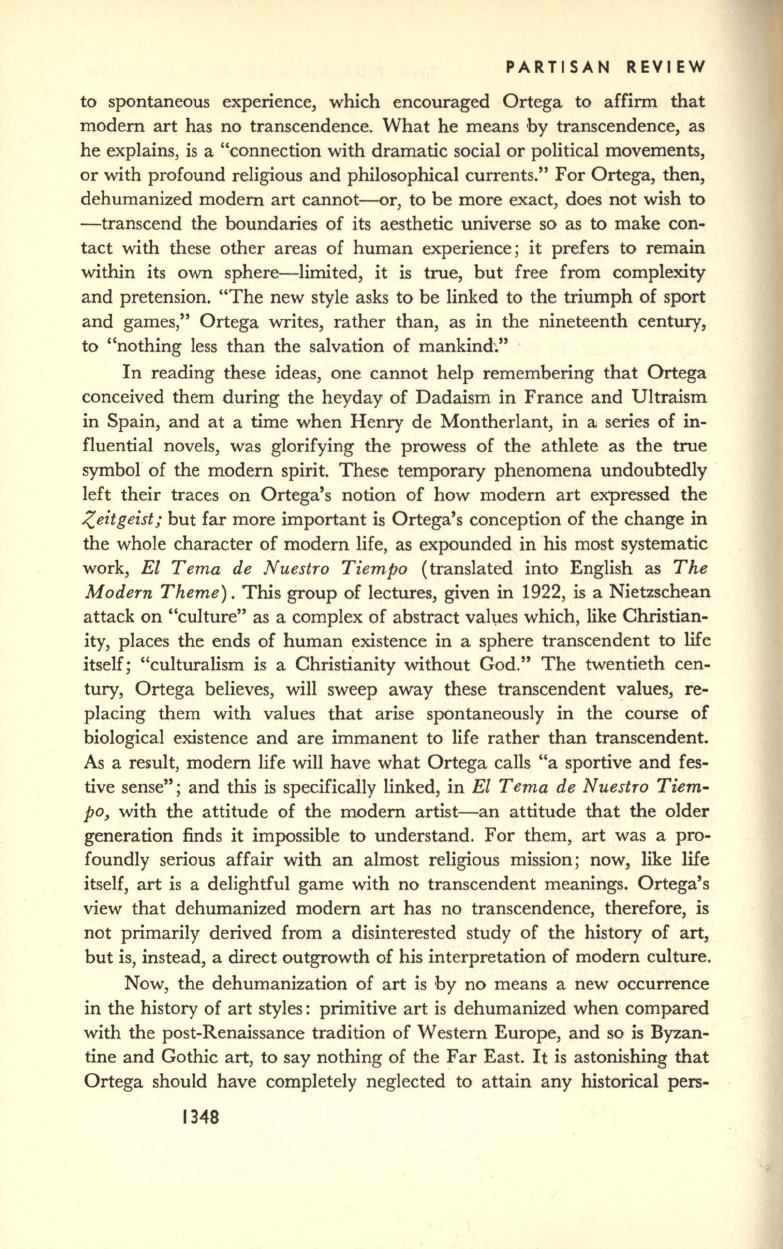
PARTISAN REVIEW
to spontaneous experience, which encouraged Ortega to affirm that
modern art has no transcendence. What he means by transcendence, as
he explains, is a "connection with dramatic social or political movements,
or with profound religious and philosophical currents." For Ortega, then,
dehumanized modem art cannot-or, to be more exact, does not wish to
-transcend the boundaries of its aesthetic universe so as to make con–
tact with these other areas of human experience; it prefers to remain
within its own sphere--limited, it is true, but free from complexity
and pretension. "The new style asks to be linked to the triumph of sport
and games," Ortega writes, rather than, as in the nineteenth century,
to "nothing less than the salvation of mankinch"
In reading these ideas, one cannot help remembering that Ortega
conceived them during the heyday of Dadaism in France and Ultraism
in Spain, and at a time when Henry de Montherlant, in a series of in–
fluential novels, was glorifying the prowess of the athlete as the true
symbol of the modem spirit. These temporary phenomena undoubtedly
left their traces on Ortega's notion of how modern art expressed the
Zeitgeist;
but far more important is Ortega's conception of the change in
the whole character of modern life, as expounded in his most systematic
work,
El Tema de Nuestro Tiempo
(translated into English as
The
Modern Theme).
This group of lectures, given in 1922, is a Nietzschean
attack on "culture" as a complex of abstract val\les which, like Christian–
ity, places the ends of human existence in a sphere transcendent to life
itself; "culturalism is a Christianity without God." The twentieth cen–
tury, Ortega believes, will sweep away these transcendent values, re–
placing them with values that arise spontaneously in the course of
biological existence and are immanent to life rather than transcendent.
As a remit, modem life will have what Ortega calls "a sportive and fes–
tive sense"; and this
is
specifically linked, in
El Tema de Nuestro Tiem–
po,
with the attitude of the modern artist-an attitude that the older
generation finds it impossible to understand. For them, art was a pro–
foundly serious affair with an almost religious mission; now, like life
itself, art is a delightful game with no transcendent meanings. Ortega's
view that dehumanized modern
art
has no transcendence, therefore, is
not primarily derived from a disinterested study of the history of art,
but is, instead, a direct outgrowth of his interpretation of modern culture.
Now, the dehumanization of art is by no means a new occurrence
in the history of art styles: primitive art is dehumanized when compared
with the post-Renaissance tradition of Western Europe, and so is Byzan–
tine and Gothic art, to say nothing of the Far East. It is astonishing that
Ortega should have completely neglected to attain any historical pers-
1348


